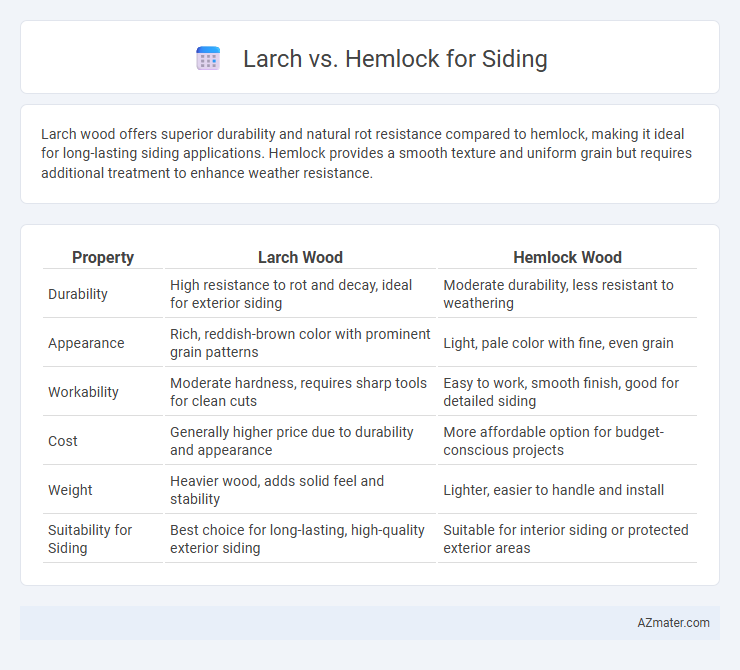Larch wood offers superior durability and natural rot resistance compared to hemlock, making it ideal for long-lasting siding applications. Hemlock provides a smooth texture and uniform grain but requires additional treatment to enhance weather resistance.
Table of Comparison
| Property | Larch Wood | Hemlock Wood |
|---|---|---|
| Durability | High resistance to rot and decay, ideal for exterior siding | Moderate durability, less resistant to weathering |
| Appearance | Rich, reddish-brown color with prominent grain patterns | Light, pale color with fine, even grain |
| Workability | Moderate hardness, requires sharp tools for clean cuts | Easy to work, smooth finish, good for detailed siding |
| Cost | Generally higher price due to durability and appearance | More affordable option for budget-conscious projects |
| Weight | Heavier wood, adds solid feel and stability | Lighter, easier to handle and install |
| Suitability for Siding | Best choice for long-lasting, high-quality exterior siding | Suitable for interior siding or protected exterior areas |
Introduction to Larch and Hemlock Siding
Larch siding is renowned for its durability, natural resistance to decay, and attractive grain patterns, making it a popular choice for exterior cladding in various climates. Hemlock siding offers a fine, even texture with good strength and stability, often favored for its smooth finish and ability to take paint or stain evenly. Both woods provide excellent insulation and weather resistance, but Larch typically surpasses Hemlock in terms of natural rot resistance and longevity for siding applications.
Botanical Overview: Larch vs Hemlock
Larch (genus Larix) is a deciduous conifer known for its needle-like leaves that turn golden in autumn before shedding, thriving in cooler climates and often favored for its natural rot resistance in siding applications. Hemlock (genus Tsuga) is an evergreen conifer featuring dense, flat needles and a fine-grained wood texture, commonly used for siding due to its stability and smooth finish. Both species offer distinct botanical characteristics influencing durability, appearance, and maintenance needs for exterior cladding projects.
Durability and Lifespan Comparison
Larch siding offers superior durability due to its dense grain and natural resistance to rot and insects, making it ideal for harsh weather conditions and providing a lifespan of 30 to 50 years with proper maintenance. Hemlock siding, while more affordable and easier to work with, is less resistant to moisture and pests, resulting in a shorter lifespan of 15 to 25 years. Choosing larch over hemlock enhances long-term performance and reduces maintenance frequency in exterior cladding applications.
Weather Resistance and Moisture Performance
Larch wood offers exceptional weather resistance due to its dense grain and natural resin content, making it highly durable against rain, snow, and UV exposure. Hemlock, while moderately resistant, is more prone to moisture absorption and may require additional treatments to prevent warping and decay. Choosing larch for siding ensures superior moisture performance and longevity in harsh climates compared to hemlock.
Appearance and Grain Differences
Larch siding features a distinctive reddish-brown hue with pronounced knots and a coarse, resinous texture that enhances rustic aesthetics, while Hemlock offers a lighter, pale cream to pinkish tone with a fine, uniform grain providing a smoother, more refined appearance. The grain patterns in Larch are more prominent and irregular, creating a textured surface that weathers gracefully, whereas Hemlock presents straighter, tighter grain lines that contribute to a cleaner, modern look. Choosing between Larch and Hemlock for siding depends on the desired visual impact--Larch for character and warmth, Hemlock for subtlety and elegance.
Maintenance Requirements for Each Wood
Larch siding offers moderate maintenance due to its natural resistance to decay and insects, requiring regular sealing or staining every 2-3 years to maintain its durability and appearance. Hemlock siding demands more frequent upkeep, as its softer wood is prone to rot and insect damage, necessitating annual treatments with preservatives and protective finishes. Both woods benefit from proper installation and routine inspections to prolong siding lifespan and performance in various climates.
Environmental Impact and Sustainability
Larch siding is highly regarded for its natural durability and resistance to decay, reducing the need for chemical treatments and frequent replacements, thereby lowering its environmental footprint. Hemlock, while less decay-resistant, is often sourced from sustainably managed forests and offers good insulation properties that contribute to energy efficiency. Both woods are renewable resources, but larch's longevity and minimal maintenance make it a more sustainable choice for siding applications.
Cost Analysis: Larch vs Hemlock Siding
Larch siding generally costs more upfront than hemlock due to its higher density and durability, which translates into greater long-term value and reduced maintenance expenses. Hemlock siding is typically less expensive initially but may require more frequent upkeep or replacement, increasing overall lifecycle costs. Evaluating total cost of ownership favors larch for projects prioritizing longevity and lower maintenance.
Best Applications and Use Cases
Larch wood, with its high durability and natural resistance to rot and insects, is ideal for exterior siding exposed to harsh weather conditions and moisture, making it especially suitable for coastal or mountainous regions. Hemlock, being softer and less resinous than larch, offers a smooth finish that is perfect for interior siding or dry, sheltered exterior areas where aesthetic appeal and ease of painting are priorities. For heavy-duty outdoor applications requiring long-lasting performance and minimal maintenance, larch is preferred, while hemlock excels in decorative and indoor settings or areas with lower exposure to moisture.
Pros and Cons Summary: Larch vs Hemlock
Larch siding offers exceptional durability and natural resistance to rot and insects, making it ideal for outdoor use, while its rich reddish hue enhances aesthetic appeal but may require regular maintenance to preserve color. Hemlock siding provides a smooth, uniform grain with a lighter color that easily accepts paints and stains, offering greater design flexibility, though it tends to be less resistant to decay and may need protective treatment. Choosing between larch and hemlock depends on prioritizing longevity and natural resistance versus affordability and ease of finishing for siding projects.

Infographic: Larch vs Hemlock for Siding
 azmater.com
azmater.com